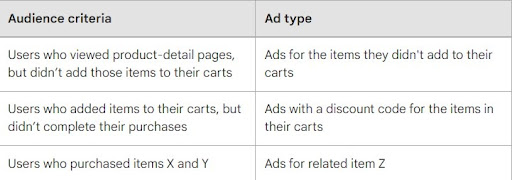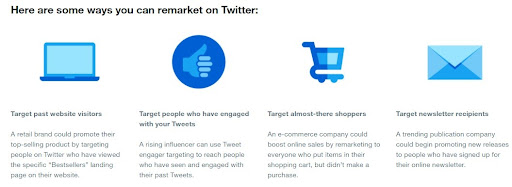Mary visited your online store and added a few items to her shopping cart. But for a reason, maybe a slow internet connection or an important phone call, she got distracted and abandoned her cart.
Mary’s case isn’t an exception: 69.8% of online shoppers abandon their shopping carts for various reasons.
So, how do online store owners struggle with this issue? With the help of remarketing.
Below we will discuss what it’s about, how it’s different from retargeting, and draw your attention to the benefits of remarketing.

What is remarketing?
Remarketing is a strategy that targets website visitors on other platforms and aims at reminding them about the business’s offer. For example, if Mary browsed through your product pages but didn’t buy anything, you can use email or ads to remind Mary of her favorite items.
Though remarketing and retargeting have the same goal in mind – bring visitors back and convert them – they are not the same.
While remarketing is mainly about targeting your audience through emails, retargeting uses paid ads to convert visitors.
However, recently the line between remarketing and retargeting has become blurrier as, for example, Facebook allows you to upload email lists and retarget them via ads.
How does remarketing work?
If you want to experience the retargeting benefits, you should first set criteria for your visitors.
Once the visitors match your requirements, cookies are placed on their device. Each cookie has a unique ID and adds the visitor to your remarketing list.
You can have multiple remarketing lists and unique criteria for each of them, thus serving different ads to different groups of visitors.
What are the benefits of remarketing?
Remarketing brings different benefits to businesses depending on their niche, product/service prices, audience, etc. Here we have a list of 6 digital remarketing benefits that are applicable almost for all businesses:
#1 Brings distracted or busy visitors back
Our day is full of distractions: social media and text messages, app notifications, phone calls…
In addition to this list, we are sometimes unable to complete online purchases because of slow internet connection, insufficient funds, etc.
Last but not least, sometimes we leave our shopping carts because we are unsure and need time to think.
All these factors are responsible for the fact that the average eCommerce conversion rate in the US is only 2.63%. A reminder based on the visitors’ browsing history will help you re-attract them and turn them into customers.
#2 Is cost-effective
Different studies and stats show that remarketing is more cost-effective than cold ads. According to WordStream, display and social remarketing ad clicks cost 2-100x less than search ads.
Why? Because your remarketing audience is already looking for a solution and has high intentions. You need to spend less or no time educating or nurturing them as they are closer to making a decision.
Besides, your remarketing audience is already familiar with your brand and needs a little trigger to choose your brand over your competitors.
#3 Improves ad relevancy
When running cold ads, businesses end up targeting people who don’t want or need their product at that moment. That’s why so many ads are marked as irrelevant by users (you have also marked an ad as irrelevant, right?). Remarketing helps improve your ad relevancy by considering your audience’s browsing history and understanding what they are looking for.
As we already mentioned, you can also segment your website visitors based on their behavior and deliver different remarketing ads to different groups. This option makes remarketing even more relevant.
#4 Has a higher CTR
According to Wishpond, the average CTR for display ads is 0.07%, while the average CTR for retargeted ads is about 0.7%. It means that retargeting ads can be as much as 10x more effective than regular ads.
Here’s the deal. The marketing rule of 7 says that a user needs 7 interactions with a brand before making a purchase. So when the user sees your ad for the first time, they are the least likely to click it or interact with it. But if they have already visited your website, read your blog, or explored reviews/testimonials, they are now more receptive to your ads and offers.
#5 Gives opportunities for customization and personalization
When users visit your website and give consent, cookies are stored in their browsers. Thus, you become able to “find” and retarget them if they don’t make a purchase or don’t book a call.
However, not all visitors qualify for remarketing. You can set criteria according to which your ads will be visible to your audience.
For example, you can remarket users who viewed your product pages but didn’t add items to their cart. Or remarket users who visited multiple pages on your website, etc.
Here’s a table from Google that shows what ads to show in this or that case:

You might also already know that acquiring a new customer is 5 times more expensive than selling to an existing customer. As you can see from the image above, remarketing isn’t only about converting visitors who never bought from you. It’s also great for remarketing your existing customers and offering them to make another purchase.
The best part of remarketing campaigns is that customization opportunities aren’t limited to audience criteria setting. You can set time criteria as well, e.g., when your audience will see your ads – after how many days or hours after taking a certain action.
In addition, you can choose on which days or at what hour to show the ad. One of the best options is to show the ad the same day of the week, and the hour they visited your site.
#6 Reach your audience when they hang out
As we already mentioned, remarketing is mostly reaching your audience via email, while retargeting is mostly about ads.
Depending on where your audience is the most active, you can choose this or that channel for remarketing. For example, Twitter allows you to target
- past website visitors,
- people who have engaged with your Tweets,
- shoppers who put items in their shopping cart but didn’t buy anything,
- people who have signed up for your online newsletter.

However, you can choose other platforms as well, including
- Facebook,
- Instagram,
- Google, etc
Harness the benefits of remarketing with Andava Digital
If your online store or another online business has a website, not using the benefits of remarketing is a big mistake. You are probably paying thousands of dollars for cold ads but not picking the low-hanging fruit. Getting started with remarketing isn’t easy, so you’d like to hire a remarketing agency that will guide you and show both technical and creative support.
Andava Digital is a full-service digital marketing agency that offers remarketing services to online stores and online businesses.
We will analyze your current traffic, set remarketing criteria for your visitors, and help you generate conversions you’ve been missing out on so far.